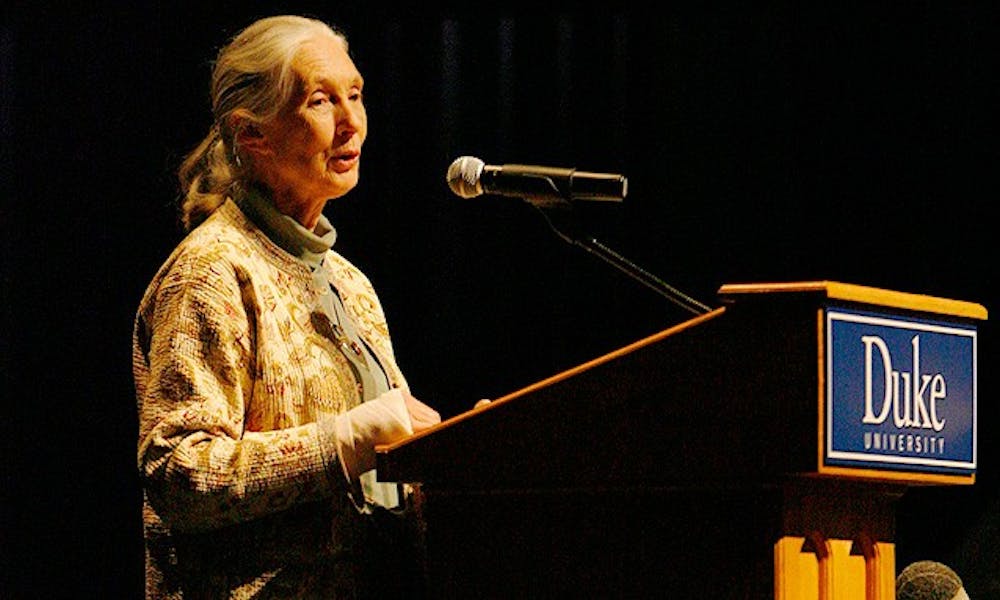Legendary primatologist Jane Goodall has brought her research to Duke.
In a keynote address titled “Gombe and Beyond: The Next 50 Years,” Goodall formally announced the transfer of 50 years’ worth of research and called on the world’s youth to protect rapidly vanishing chimpanzee habitats and the environment. She spoke Monday to a packed Page Auditorium, with an overflow crowd filling Reynolds Industries Theater.
The speech marked the conclusion of the recent Primate Palooza, the week-long festival on primate conservation presented by Duke’s evolutionary anthropology department and the Duke and University of North Carolina at Chapel Hill Roots & Shoots, a local chapter of an organization founded by Goodall to promote people, animals and the environment.
“The tragedy is that even as we speak, there are chimpanzee populations being threatened by human development,” Goodall said during a press conference before her speech. “This points to how important it is to preserve and protect chimpanzees.”
Anne Pusey, chair of Duke’s evolutionary anthropology department, and a team of researchers are currently in the process of digitizing approximately 400,000 documents from more than 50 years of research Goodall conducted at Gombe National Park in Tanzania. Pusey previously worked on the collection at the University of Minnesota before coming to Duke about a year ago.
Alvin Crumbliss, interim dean of the faculty of Arts and Sciences, said in an interview that the arrival of Goodall’s documents provides multidimensional benefits to the University, such as introducing new methods of data mining.
“If you have 50 years of data, you can digitize that and have it available in a meaningful form,” Crumbliss said. “You can form hypotheses, look for data patterns and so on. It’s a wonderful resource on several levels.”
Although time-consuming, digitizing the data will make it easier for primate researchers to draw conclusions about trends and patterns, Goodall said.
She said jokingly that until recently, her pages of field data remained unexamined, “chewed up by mice, termites and leaf-eating insects.”
Still, she said parting with her research will be a “bittersweet” experience. Much of it was painstakingly collected in handwritten notes that she worked on in the field while she was in her mid-20s.
“These amazing things that are now happening are going to make it so easy compared to what I had to do, which was all by hand and on paper,” she said. “Coming back and seeing what is going on makes me quite homesick for the days when I was doing that, [but] it’s wonderful to know that this data is being analyzed and that we will gain answers from analyzing it.”
Goodall’s keen interest in animals dates back to her childhood. She recalled one day when, charged with picking up eggs on a farm, she hid in the hay of the henhouse in order to figure out how an egg could possibly come out of a hen.
She began observing chimpanzees in July 1960 at the age of 26. While in Gombe, Goodall revolutionized primate studies when she overturned the dominant anthropological belief at the time that the use of tools set humans apart from animals. The discovery also paved the way for National Geographic funding, allowing Goodall to continue her research. She went on to relate some of her notable discoveries about the behavior of chimpanzees, which spanned from brutality to altruism.
Although Goodall acknowledged the many imminent dangers facing chimpanzee populations from loss of habitat, hunting and global climate change, she ended on a note of optimism—citing the accomplishments of Roots & Shoots organizations, the potential of human intellect for correcting self-destructive policies, the resilience of the environment and “the indomitable human spirit, the people who tackle seemingly impossible problems and never give up.”
Goodall demonstrated a similar spirit, appearing at Duke despite recently breaking her arm after taking a fall.
Goodall also drew a sizable audience from beyond the Duke community.
“As a teacher, it was really helpful to hear how she’s working with kids [about threats to the environment]—I’ve felt that factor, too, of we’re just scaring the hell out of them, and how do you teach conscientiousness without scaring kids?” said elementary school science teacher Kirsty Lubicz-Nawrocka, who traveled from Atlanta. “I don’t think I’ve ever wanted to see somebody more in person than [Goodall].”
Get The Chronicle straight to your inbox
Signup for our weekly newsletter. Cancel at any time.

